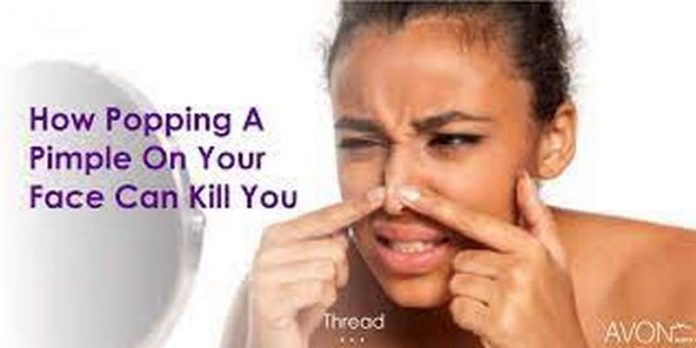Although rare, popping acne (pimple) in the “danger triangle”—previously known as the “triangle of death”—may cause an infection of the face or head. The “danger triangle” consists of the area from the corners of your mouth to the bridge of your nose.
An infection of that area can lead to cavernous sinus thrombosis (CST), or a rare blood clot in your cavernous sinuses. A blood clot in your cavernous sinuses can delay blood flow from your brain.
Due to the risk of life-threatening infection, you may wonder if and how it’s okay to pop pimples on your face. According to dermatologists, here’s what you need to know about the “danger triangle” and when (if at all) you can pop pimples on your face safely.
What Is the ‘Triangle of Death’?
The “triangle of death” is an old term for what many experts now call the “danger triangle.”
“The area of the face connecting the nose to the corners of the mouth is thought to be a particularly dangerous area of the face because of their close connection to the brain,” Joshua Zeichner, MD, an associate professor of dermatology at Mount Sinai Hospital in New York, told Health.
The best way to see the triangle is to form one with your fingers—connecting the tips of your thumbs, then the tips of your pointer fingers. On your face, the top of your triangle is on the bridge of your nose. The base starts at either corner of your mouth and extends across the bottom of your upper lip.
Risks of Popping Pimples in the ‘Danger Triangle’

The phrase “danger triangle” might sound slightly extreme when talking about pimple popping. Still, practicing care near that area of your face is critical. Picking at or scratching pimples on that area is not wise since it can allow bacteria to enter and cause infection.
In general, the American Academy of Dermatology Association (AAD) does not advise that you pop your pimples. You may push the contents of the pimple deeper into the skin, leading to complications like permanent scarring and more painful and noticeable acne.
Infection
Popping a pimple in the “danger triangle” runs the risk of a potentially life-threatening infection. As a result, Cystic Acne (CST) may develop, in which a blood clot forms in your cavernous sinuses and blocks blood flow from your brain.2
“The cavernous sinus is the name of a large vein that drains blood to the brain, creating a connection from our outside to our inside,” said Dr. Zeichner. In other words, the infection in a pimple on your nose has a somewhat clear path to your brain.
For that reason, “any infection in that area is a little bit higher risk,” Alok Vij, MD, a dermatologist at the Cleveland Clinic, told Health.
“In the event that you pick a pimple, and an infection develops, the worst-case scenario is that the infection spreads from the skin through this sinus,” explained Dr. Zeichner.
CST is a dangerous disorder, but recognising the symptoms right away minimises the risk of death and complications. CST symptoms include:
Fever
Headache
Paralysis of the muscles that control eye movements
Swelling around the eyes
More Noticeable and Painful Acne
Frequently touching your face increases the risk of more acne.4 When you pop pimples, bacteria, dead skin cells, and oil push further into your skin. As a result, more swelling and redness occur, making acne appear more noticeable and painful.
When To See a Healthcare Provider
At-home treatments can help get rid of and prevent acne. Still, some people may have more stubborn acne than others.
Consult a dermatologist if you notice:
At-home treatments do not get rid of or prevent acne within several months
Cysts
Emotional distress or social anxiety about acne
Redness around pimples
Scars form as acne clears
Worsening acne


